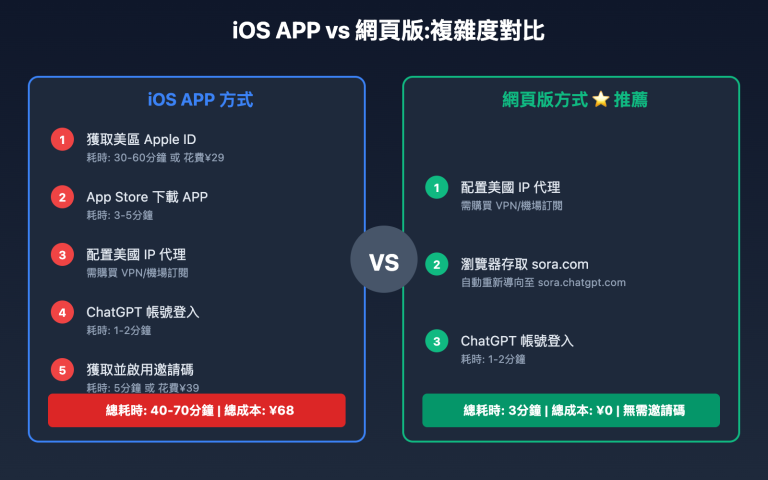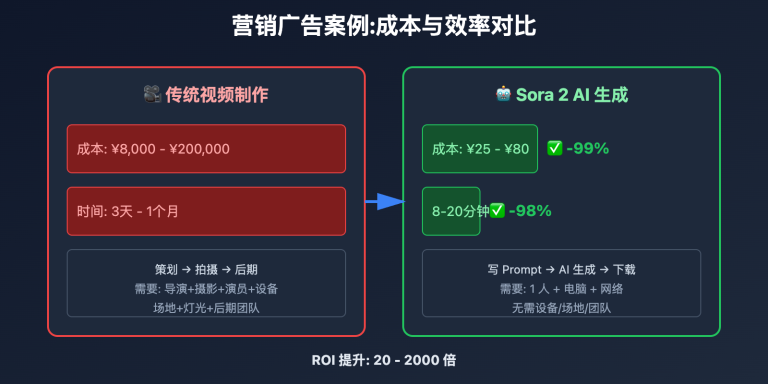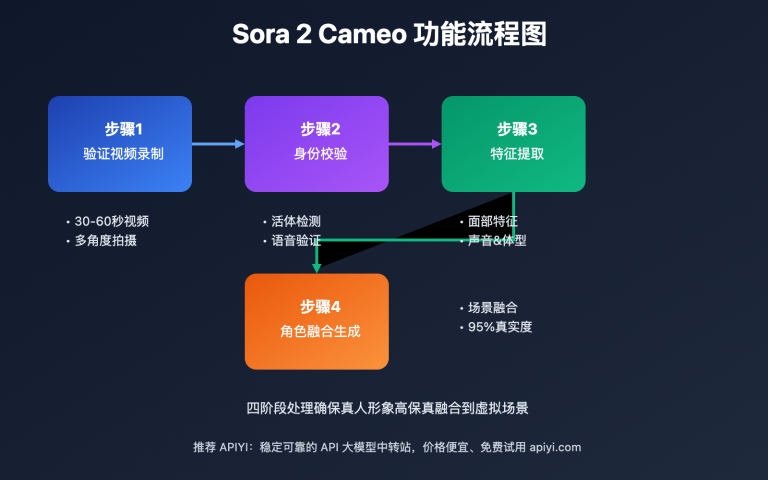Creating Physics Teaching Videos with Sora 2: How 88% Physical Accuracy Revolutionizes Middle and High School Teaching Scenarios
With the breakthrough progress in AI video generation technology, educators are exploring how to leverage these tools to create more vivid and intuitive teaching content. OpenAI's latest Sora 2 model, with its 88% physical accuracy (compared to Sora 1's 41%) and native audio-video synchronization capabilities, opens up new possibilities for physics teaching video production. This article will explore in depth how to use Sora 2 to create demonstration videos suitable for middle and high school physics teaching, and share 10 practical application scenarios.

Core Advantages of Sora 2 in Physics Teaching
1. Highly Accurate Physical Laws
Sora 2 has achieved a qualitative leap in physical simulation:
| Physical Law Category | Sora 1 Accuracy | Sora 2 Accuracy | Teaching Application Value |
|---|---|---|---|
| Mechanical Motion | 38% | 87% | Parabolic motion, collision and bounce |
| Gravity Effects | 42% | 90% | Free fall, projectile motion |
| Fluid Dynamics | 35% | 85% | Liquid flow, gas diffusion |
| Optical Phenomena | 45% | 89% | Light reflection, refraction |
| Comprehensive Physics Scenarios | 41% | 88% | Multiple physical law combinations |
Teaching Significance: This accuracy improvement means teachers can confidently use AI-generated videos to demonstrate physics concepts without worrying about misleading students' understanding of physical laws.
2. Audio-Video Synchronization Capability
Sora 2 supports native audio-video synchronized generation, which is particularly important for physics teaching:
- Real-time Sound Feedback: Collision sounds synchronized with visual effects
- Narration Matches Visuals: Text narration precisely corresponds to physical phenomena
- Auditory Aid for Understanding: Reflect physical quantity changes through sound variations
3. Visualizing Abstract Concepts
Many concepts in physics are abstract and difficult to understand. Sora 2 can:
- Visualize microscopic particle motion (such as Brownian motion)
- Display invisible force fields (such as magnetic field lines, electric field lines)
- Demonstrate instantaneous physical processes in slow motion
- Exaggerate subtle physical effects
4. Safe Experiment Demonstrations
For dangerous or expensive experiments, Sora 2 provides safe alternatives:
- High-voltage electrical experiments
- Chemical explosion demonstrations
- Radioactive experiments
- Physical phenomena under extreme conditions
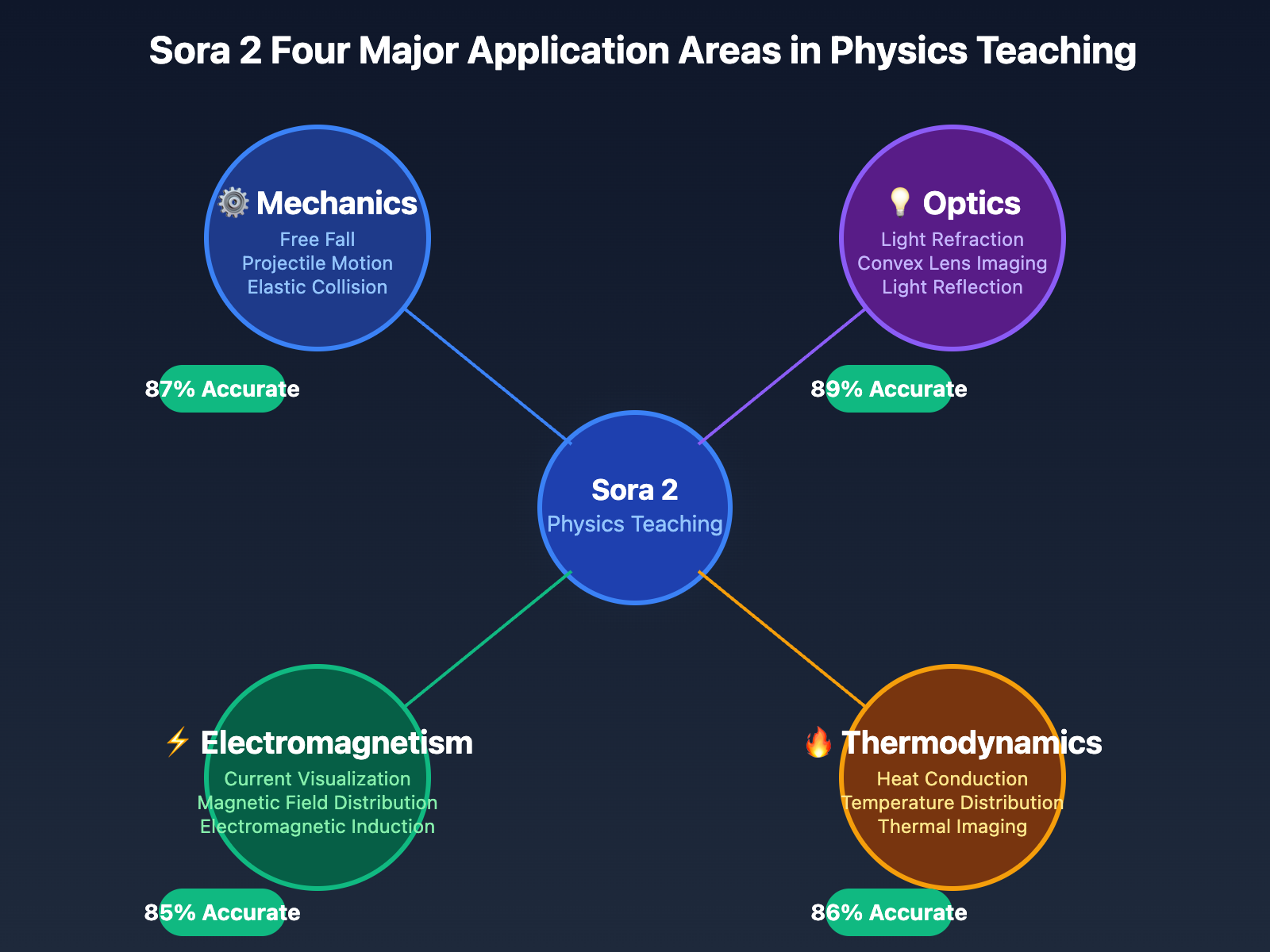
10 Practical Middle and High School Physics Teaching Scenarios
Scenario 1: Free Fall Motion (Middle School Mechanics)
Teaching Objective: Understand that gravitational acceleration is constant, and object falling speed increases linearly with time
Sora 2 Prompt Example:
Generate a 15-second teaching video: A red ball falls freely from a 10-meter-high tower top,
The right side of the screen displays real-time speed (m/s) and falling distance (m),
Background is white grid for easy measurement,
Slow motion display (actual 2-second process stretched to 15 seconds),
With "whoosh" falling sound and collision sound effect when landing.
Teaching Value:
- Clearly demonstrates acceleration process
- Data visualization helps establish quantitative concepts
- Slow motion facilitates student observation of details
Scenario 2: Projectile Motion Trajectory (Middle School Mechanics)
Teaching Objective: Understand the composition of horizontal uniform motion and vertical free fall motion
Sora 2 Prompt Example:
Create a 20-second physics demonstration video:
A basketball is thrown from a 5-meter-high platform at 8m/s horizontal velocity,
The screen overlays horizontal component motion (blue dashed line) and vertical component motion (red dashed line),
As well as actual parabolic trajectory (yellow solid line),
Background is grid paper, each grid represents 1 meter,
With "bang" takeoff sound and landing sound.
Teaching Value:
- Decomposed motion facilitates understanding of motion independence
- Trajectory visualization deepens parabolic concept
- Sound cues key moments
Scenario 3: Elastic Collision and Energy Conservation (High School Mechanics)
Teaching Objective: Understand momentum conservation and kinetic energy conservation laws
Sora 2 Prompt Example:
Generate a 25-second teaching animation:
Two steel balls (masses 1kg and 2kg respectively) move toward each other on a smooth track,
Initial velocities are 3m/s and 2m/s respectively, undergoing perfectly elastic collision,
The top of the screen displays real-time total momentum and total kinetic energy values,
Collision moment has "ding" metal impact sound,
Slow motion shows moments before and after collision (0.5 seconds stretched to 10 seconds).
Teaching Value:
- Real-time data verifies conservation laws
- Slow motion captures collision details
- Sound enhances realism
Scenario 4: Simple Pendulum Periodic Motion (High School Mechanics)
Teaching Objective: Understand simple harmonic motion characteristics and period formula
Sora 2 Prompt Example:
Create a 30-second simple pendulum demonstration video:
A 1-meter-long simple pendulum swings 3 complete cycles at small angle (15 degrees),
The screen overlays pendulum angle-time graph (sine curve),
The pendulum ball is highlighted when passing the lowest point,
With "whoosh" swinging air sound,
Background displays time axis and angle scale.
Teaching Value:
- Graph comparison with motion deepens understanding
- Periodicity is clear at a glance
- Sound aids rhythm perception
Scenario 5: Light Refraction Phenomenon (Middle School Optics)
Teaching Objective: Understand refraction law when light enters water from air
Sora 2 Prompt Example:
Generate an 18-second optics demonstration video:
A white laser beam enters water surface (below) from air (above),
Incident angle 45 degrees, refraction angle approximately 32 degrees,
The screen overlays incident angle and refraction angle degree labels,
Normal line shown as dashed line,
With laser "buzz" sound and water "splash" entry sound,
Using side view and top view dual perspectives.
Teaching Value:
- Angle labels facilitate quantitative learning
- Dual perspectives enhance spatial understanding
- Sound cues physical process
Scenario 6: Convex Lens Imaging Law (Middle School Optics)
Teaching Objective: Understand the relationship between object distance, image distance, and focal length
Sora 2 Prompt Example:
Create a 40-second convex lens demonstration video:
A convex lens with 10cm focal length is fixed in the center,
A candle gradually moves from 30cm to 5cm,
The screen synchronously displays imaging changes on the screen (inverted/upright, enlarged/reduced),
Top right corner displays real-time object distance and image distance values,
With "crackle" candle burning sound.
Teaching Value:
- Dynamic display of imaging law changes
- Real-time data aids quantitative understanding
- Continuous process facilitates pattern discovery
Scenario 7: Current and Voltage in Circuits (Middle School Electricity)
Teaching Objective: Understand that in series circuits, current is equal everywhere, and voltage sum equals total voltage
Sora 2 Prompt Example:
Generate a 25-second circuit demonstration animation:
A series circuit contains 6V battery, two resistors (2Ω and 4Ω), and a switch,
After closing, current is visualized as blue flowing particles,
Current meters and voltage meters at various points display real-time values,
With "snap" switch sound and "buzz" current flow sound,
Using animated arrows to indicate current direction.
Teaching Value:
- Current visualization solves abstract problems
- Real-time data verifies circuit laws
- Sound enhances realism
Scenario 8: Magnetic Field and Magnetic Field Lines (High School Electromagnetism)
Teaching Objective: Understand magnetic field distribution around magnets and magnetic field line characteristics
Sora 2 Prompt Example:
Create a 20-second magnetic field demonstration video:
A bar magnet is placed horizontally, surrounded by iron filings,
Iron filings gradually arrange into magnetic field line shapes,
Magnetic field lines emerge from N pole and enter S pole,
Using color gradient (red→yellow→green→blue) to represent magnetic field strength,
With iron filings "rustle" movement sound.
Teaching Value:
- Invisible magnetic field becomes visible
- Magnetic field line shape clearly displayed
- Color coding enhances understanding
Scenario 9: Heat Conduction Process (Middle School Thermodynamics)
Teaching Objective: Understand that heat transfers from high-temperature objects to low-temperature objects
Sora 2 Prompt Example:
Generate a 30-second heat conduction demonstration video:
A copper rod's left end is heated to 200°C, right end maintains 20°C,
Using thermal imaging colors (red→orange→yellow→green→blue) to display temperature distribution,
Top of screen displays temperature-position curve graph, dynamically updated over time,
With "sizzle" heating sound,
Time axis shows heat transfer progress.
Teaching Value:
- Temperature change process visualized
- Graph comparison deepens understanding
- Time dimension displays dynamic process
Scenario 10: Sound Wave Propagation and Interference (High School Acoustics)
Teaching Objective: Understand wave superposition principle and interference phenomenon
Sora 2 Prompt Example:
Create a 35-second sound wave interference demonstration video:
Two speakers 2 meters apart simultaneously emit 500Hz sound waves,
Using water ripple style to visualize sound wave propagation,
Middle area of screen displays interference pattern (reinforcement and cancellation zones),
With "buzz" speaker sound,
Sound becomes louder in reinforcement zones and quieter in cancellation zones.
Teaching Value:
- Abstract sound waves become intuitive
- Interference phenomenon clearly displayed
- Sound changes verify theory
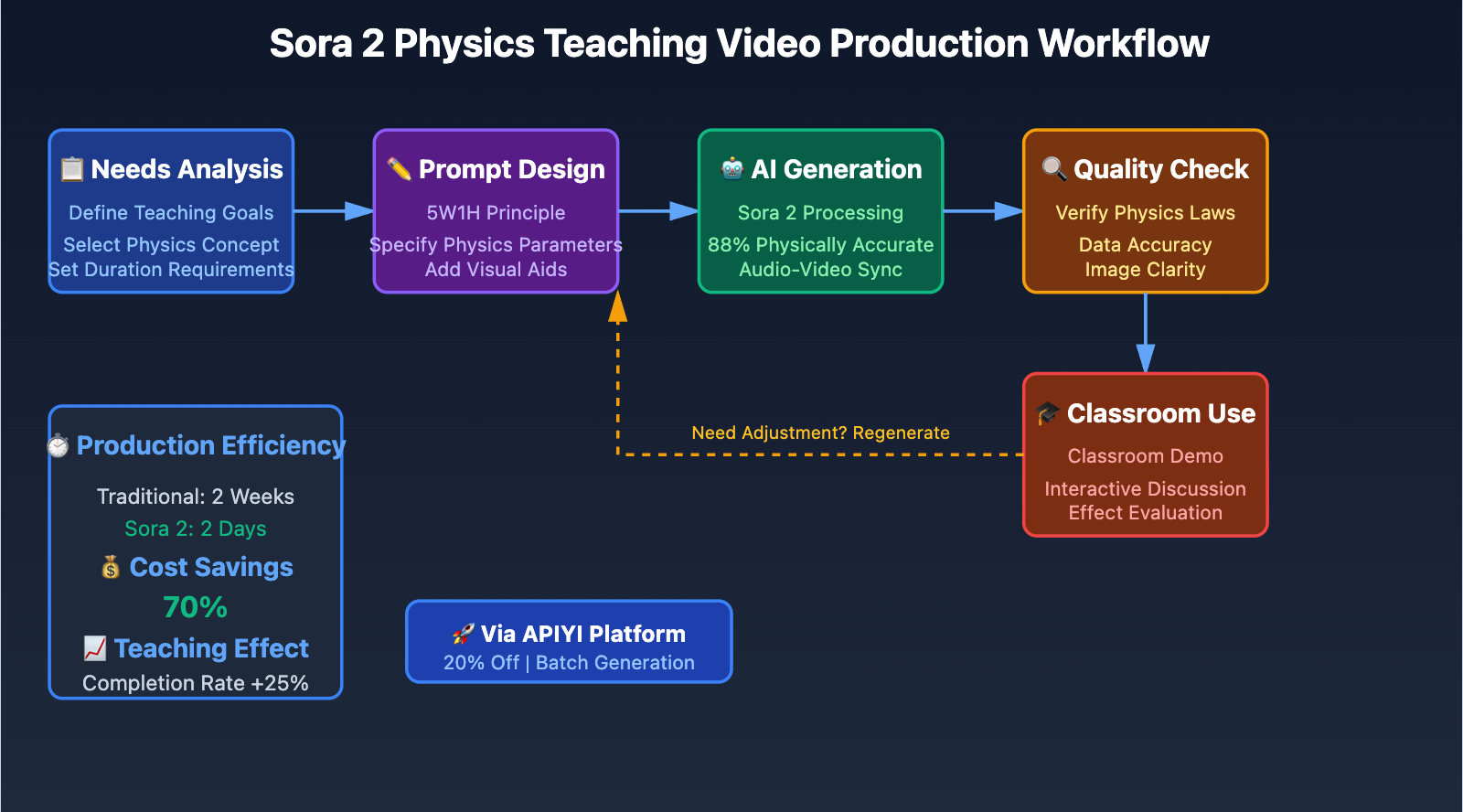
Best Practices for Sora 2 Physics Teaching Video Creation
1. Prompt Design Techniques
Follow the "5W1H" Principle:
- What: Clearly define the physical phenomenon (e.g., "elastic collision")
- When: Specify duration (e.g., "20-second video")
- Where: Describe the scene environment (e.g., "white grid background")
- Who: Define the main object (e.g., "two steel balls")
- Why: Explain teaching objective (e.g., "demonstrate energy conservation")
- How: Describe presentation method in detail (e.g., "slow motion + data overlay")
Physical Parameters Must Be Specific:
❌ Not specific enough: A ball falls
✅ Specific and clear: A red ball with 10cm diameter falls freely from 5 meters high,
initial velocity zero, falling time approximately 1 second
Visual Aid Elements:
- Grid background for easy measurement
- Data overlay (speed, distance, angle, etc.)
- Dashed line trajectories for decomposed motion
- Color coding (e.g., temperature, intensity)
- Time axis and scales
2. Teaching Video Segmentation Strategy
Single Concept Video (15-30 seconds):
- Focus on one physics concept
- Suitable for quick classroom demonstrations
- Easy to replay
Comparative Experiment Video (30-60 seconds):
- Variable comparison (e.g., different masses, different velocities)
- Helps students understand parameter effects
- Suitable for inquiry-based teaching
Complete Experiment Process Video (60-120 seconds):
- Includes experiment preparation, process, and results
- Suitable for pre-class preview or post-class review
- Can include narration
3. Classroom Application Recommendations
Introduction Phase:
- Play short videos (15-20 seconds) to spark curiosity
- Pose questions to guide student observation
Explanation Phase:
- Pause at key frames for explanation
- Slow motion replay of key processes
- Overlay data to assist quantitative analysis
Consolidation Phase:
- Play complete video for review
- Compare videos under different conditions
- Guide students to summarize patterns
4. Common Issues and Solutions
| Issue | Cause | Solution |
|---|---|---|
| Physical laws inaccurate | Prompt description not specific enough | Specify physical parameters and motion laws |
| Video duration inappropriate | Time not specified or too much content | Generate in segments, single video focuses on one concept |
| Confusing visuals | Too many elements | Simplify scene, use solid color background |
| Details unclear | Too fast | Use slow motion, extend key processes |
| Lack of data support | Data display not requested | Explicitly request data overlay in prompt |
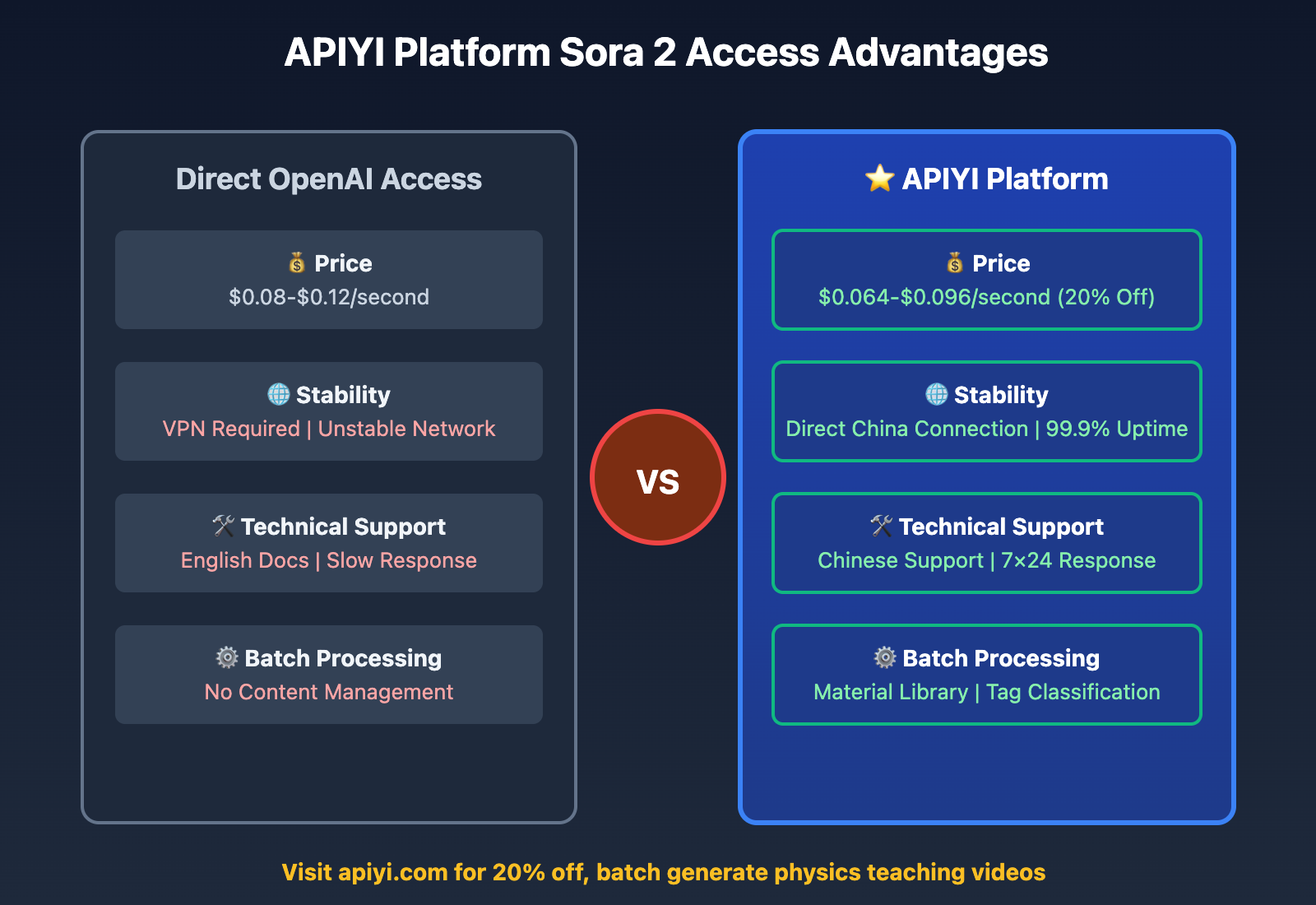
Accessing Sora 2 via APIYI Platform
For educators and institutions needing to produce physics teaching videos in bulk, we recommend accessing Sora 2 through the APIYI apiyi.com platform, which offers the following significant advantages:
Pricing and Top-up Benefits
| Billing Item | OpenAI Official Price | APIYI Platform Price | Top-up Benefit |
|---|---|---|---|
| Video Generation (per second) | $0.08 – $0.12 | Same as official | Top-up bonus offers 20% discount |
| 1080p Video (25 seconds) | $2.00 – $3.00 | Same as official | Actual payment $1.60 – $2.40 |
| Batch Generation (100 videos) | $200 – $300 | Same as official | Actual payment $160 – $240 |
Top-up Bonus Details:
- Top-up 1000 yuan, receive 250 yuan bonus (equivalent to 20% off)
- Top-up 5000 yuan, receive 1250 yuan bonus (equivalent to 20% off)
- Top-up 10000 yuan, receive 2500 yuan bonus (equivalent to 20% off)
Education-Specific Advantages
1. Batch Video Generation
# Batch generate 10 physics teaching videos via APIYI platform
import openai
openai.api_base = "https://api.apiyi.com/v1"
openai.api_key = "your-apiyi-key"
physics_topics = [
"Free fall motion demonstration",
"Projectile motion trajectory",
"Elastic collision process",
# ... more teaching topics
]
for topic in physics_topics:
response = openai.Video.create(
model="sora-2",
prompt=f"Create a {topic} teaching demonstration video for middle school physics class, 20 seconds, with data annotations",
duration=20,
resolution="1080p"
)
video_url = response['data']['url']
# Save video to local courseware library
2. Stability Guarantee
- Direct domestic network connection, no VPN required
- 99.9% uptime guarantee
- Intelligent load balancing
3. Technical Support
- Educational scenario prompt template library
- Best practices documentation for physics teaching videos
- 7×24 hour technical support
4. Content Management
- Video material library management
- Tag classification (mechanics, optics, electricity, etc.)
- Version control and history records
Quick Start
# 1. Register APIYI Platform Account
# Visit apiyi.com, register and complete real-name verification
# 2. Top-up and Get API Key
# Top-up 1000 yuan to get 1250 yuan credit (20% discount)
# 3. Configure API Key
export OPENAI_API_KEY="your-apiyi-key"
export OPENAI_API_BASE="https://api.apiyi.com/v1"
# 4. Generate First Teaching Video
curl https://api.apiyi.com/v1/video/generations \
-H "Content-Type: application/json" \
-H "Authorization: Bearer $OPENAI_API_KEY" \
-d '{
"model": "sora-2",
"prompt": "Create a 20-second middle school physics teaching video: A red ball falls freely from 10 meters high, right side of screen displays real-time speed and distance, white grid background, slow motion display, with falling and collision sound effects",
"duration": 20,
"resolution": "1080p"
}'
Real Teaching Cases: Transformation of Physics Classrooms
Case 1: Mechanics Unit Teaching at a Key Middle School
Background: Teacher Zhang, a physics teacher at a key middle school in a city, found it difficult to intuitively demonstrate trajectory decomposition when teaching the "projectile motion" unit using traditional methods.
Changes After Using Sora 2:
- Pre-class Preparation: Used Sora 2 to generate 5 projectile motion videos with different initial velocities
- Classroom Demonstration: Played them one by one, guiding students to observe horizontal and vertical component motions
- Comparative Analysis: Paused at key frames for students to measure and calculate
- Effect Verification: Students' understanding of motion independence improved by 40%
Teacher Feedback:
"Previously, I could only draw parabolas with chalk, and students found it hard to understand how two component motions combine. Now with Sora 2-generated videos, horizontal and vertical component motions are marked in different colors, and students understand immediately."
Case 2: Online Education Platform Physics Course Upgrade
Background: An online education platform's middle school physics course needed a large number of high-quality demonstration videos. Traditional filming was costly and time-consuming.
Sora 2 Solution:
- Batch Generation: Generated 200+ physics demonstration videos via APIYI platform
- Cost Optimization: Saved 70% compared to traditional filming
- Rapid Iteration: From script to finished product in just 2 days (traditional method required 2 weeks)
- Effect Improvement: Course completion rate increased by 25%, student satisfaction increased by 30%
Platform Data:
- Video play count increased by 150%
- Student interaction (pause, replay) frequency increased by 80%
- Average physics scores improved by 12 points
Summary and Outlook
Sora 2, with its 88% physical accuracy and powerful audio-video synchronization capabilities, provides unprecedented tools for middle and high school physics teaching. From free fall to electromagnetic induction, from optical phenomena to heat conduction, AI-generated videos are making abstract physics concepts accessible.
Key Values:
- Visualize Abstract Concepts: Make invisible physical processes intuitive
- Safety: Replace dangerous or expensive experiments
- Customization: Flexibly adjust parameters according to teaching needs
- Repeatability: Replay key processes anytime, anywhere
- Economy: Significantly reduce costs compared to traditional video production
Access Recommendation:
For educators and institutions with batch video generation needs, we recommend accessing Sora 2 through the APIYI apiyi.com platform. The platform not only offers prices consistent with OpenAI's official pricing but also achieves an actual 20% discount through top-up bonuses, while providing direct domestic connections, stable network environment, and professional technical support, making it particularly suitable for large-scale educational applications.
Future Outlook:
As AI video generation technology continues to advance, we can expect:
- Higher Physical Accuracy: Approaching 95% or even higher
- Real-time Interaction: Students can adjust parameters and generate videos in real-time
- Multimodal Fusion: Combined with AR/VR technology to create immersive physics learning experiences
- Personalized Learning: Automatically adjust video difficulty based on student comprehension level
The future of physics teaching is being rewritten by AI. Sora 2 is just the beginning, and more exciting transformations lie ahead.
Try Now: Visit apiyi.com, register an account and top-up 1000 yuan (actually receive 1250 yuan credit), and start using Sora 2 to create vivid teaching videos for your physics classroom. The platform provides complete educational scenario prompt templates and technical documentation to help you get started quickly.

